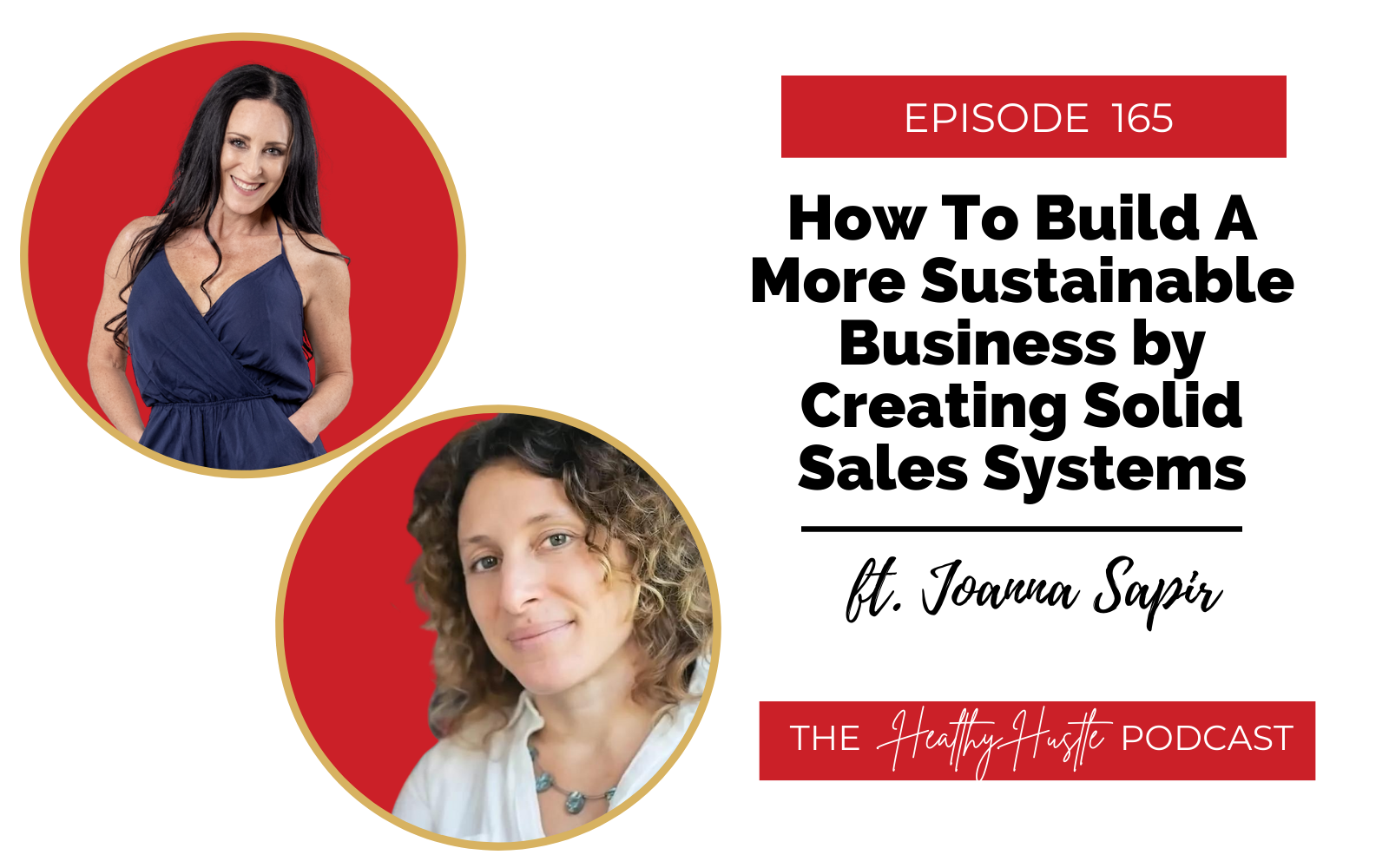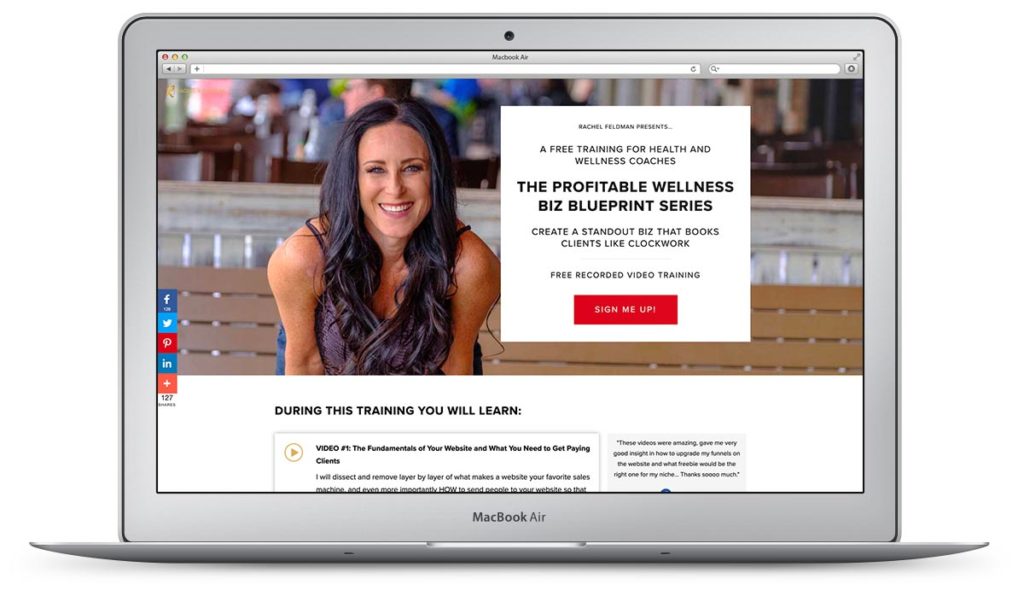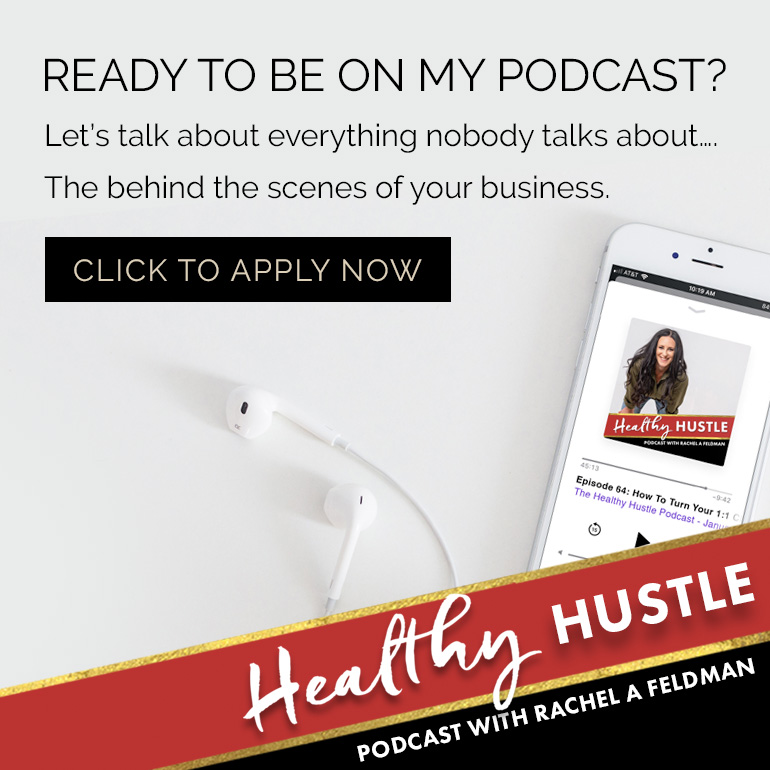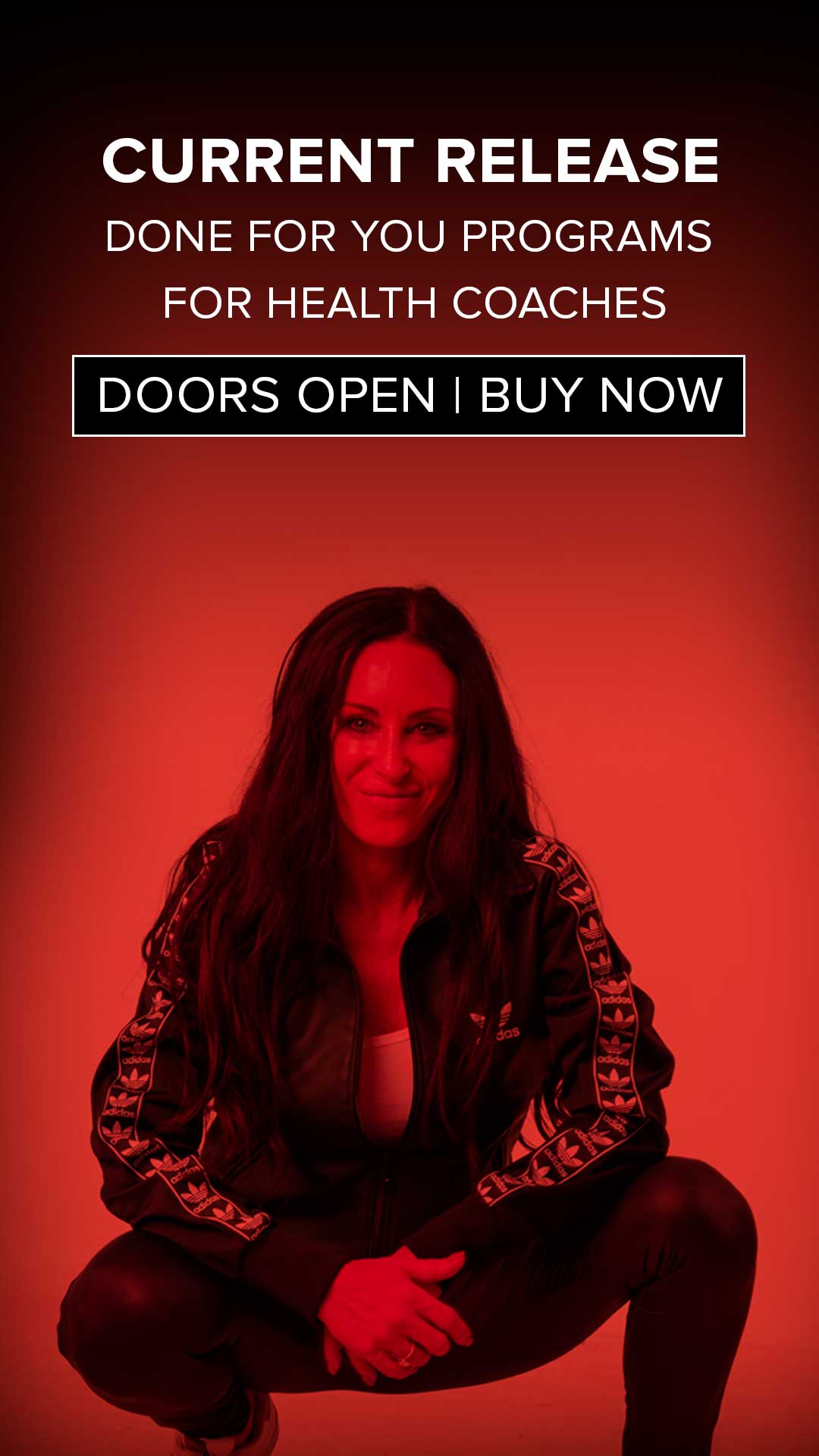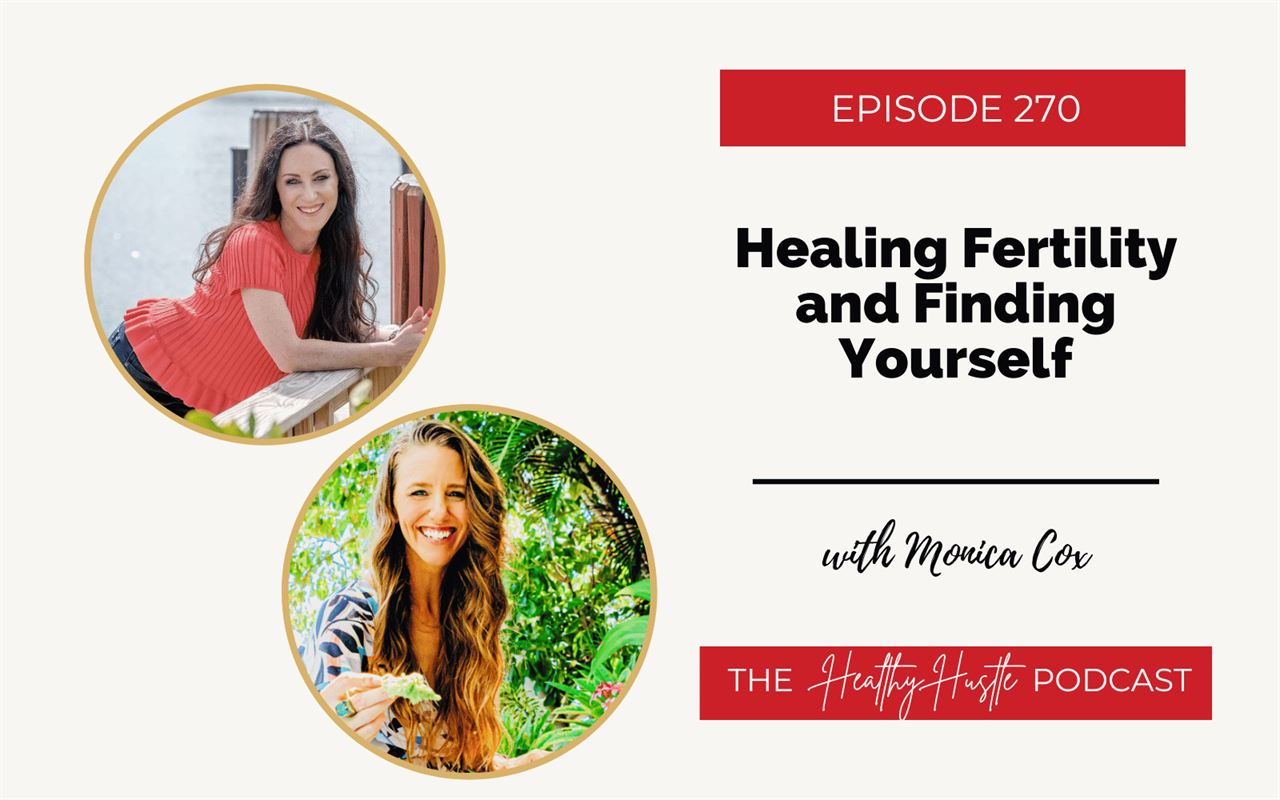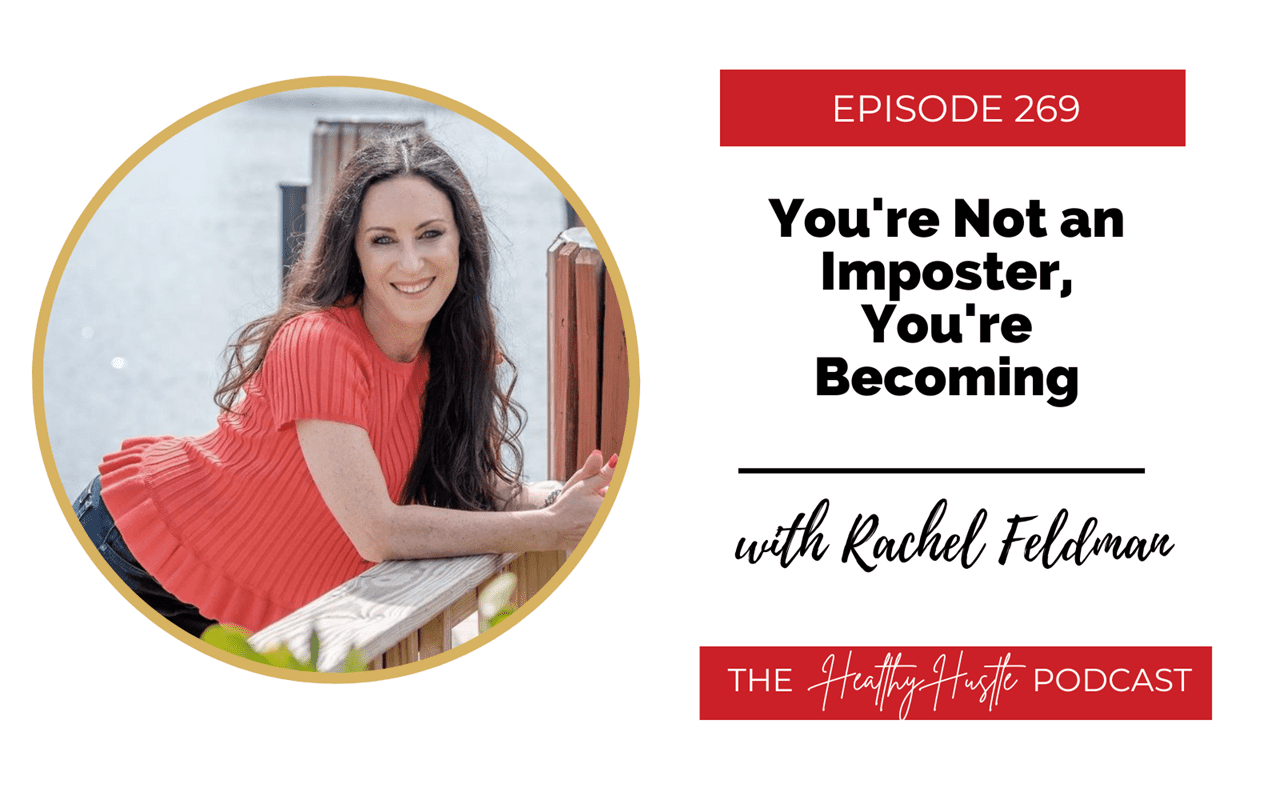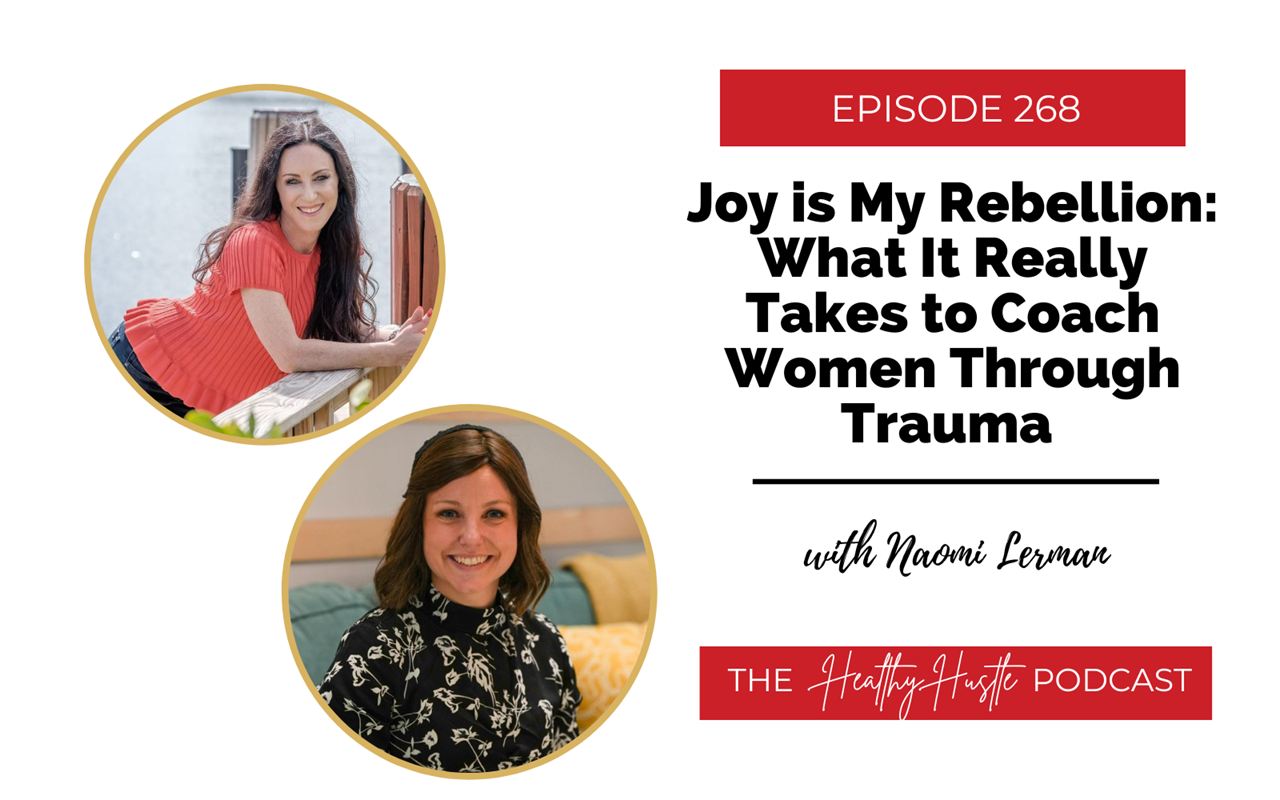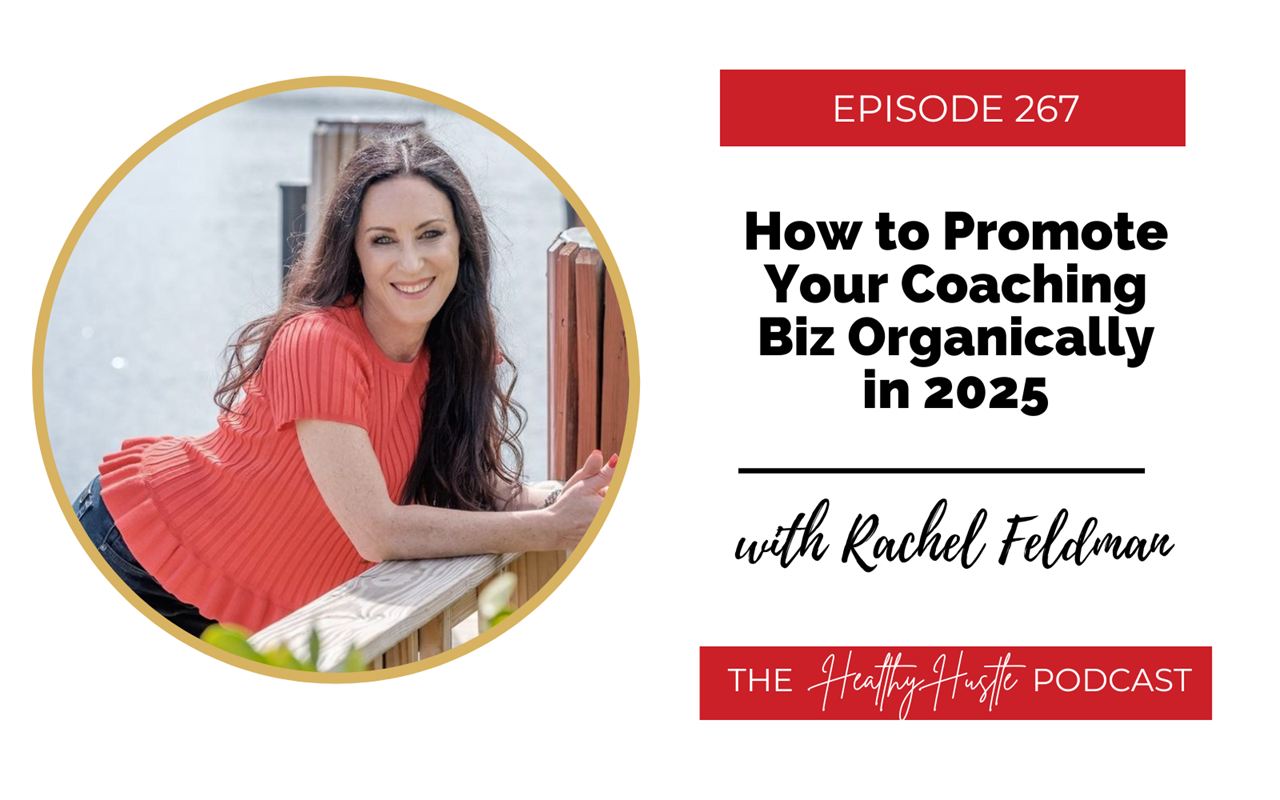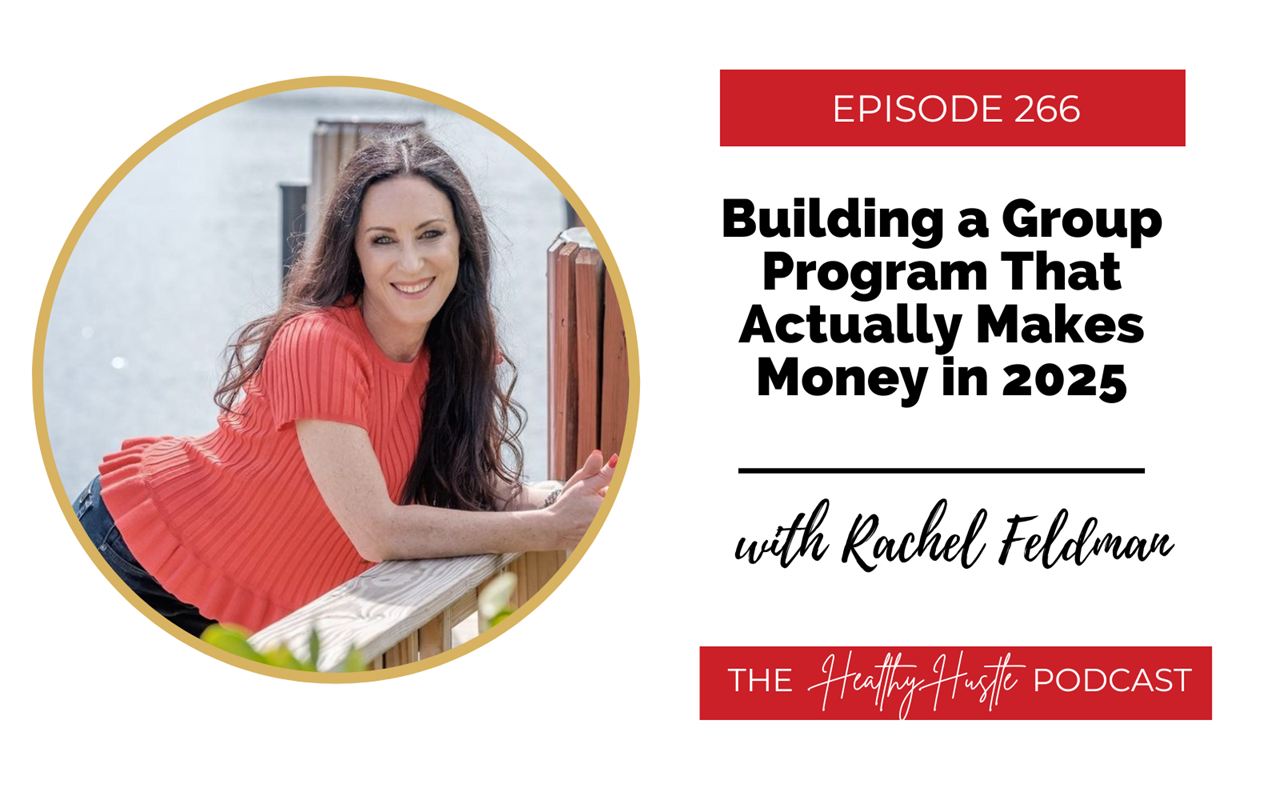Do you know what every health coach desperately needs? A streamlined sales process.
You might be thinking you need to perfect your marketing before you even start thinking about sales, but today’s guest is here to explain why your efforts should actually be going into your sales process and systems!
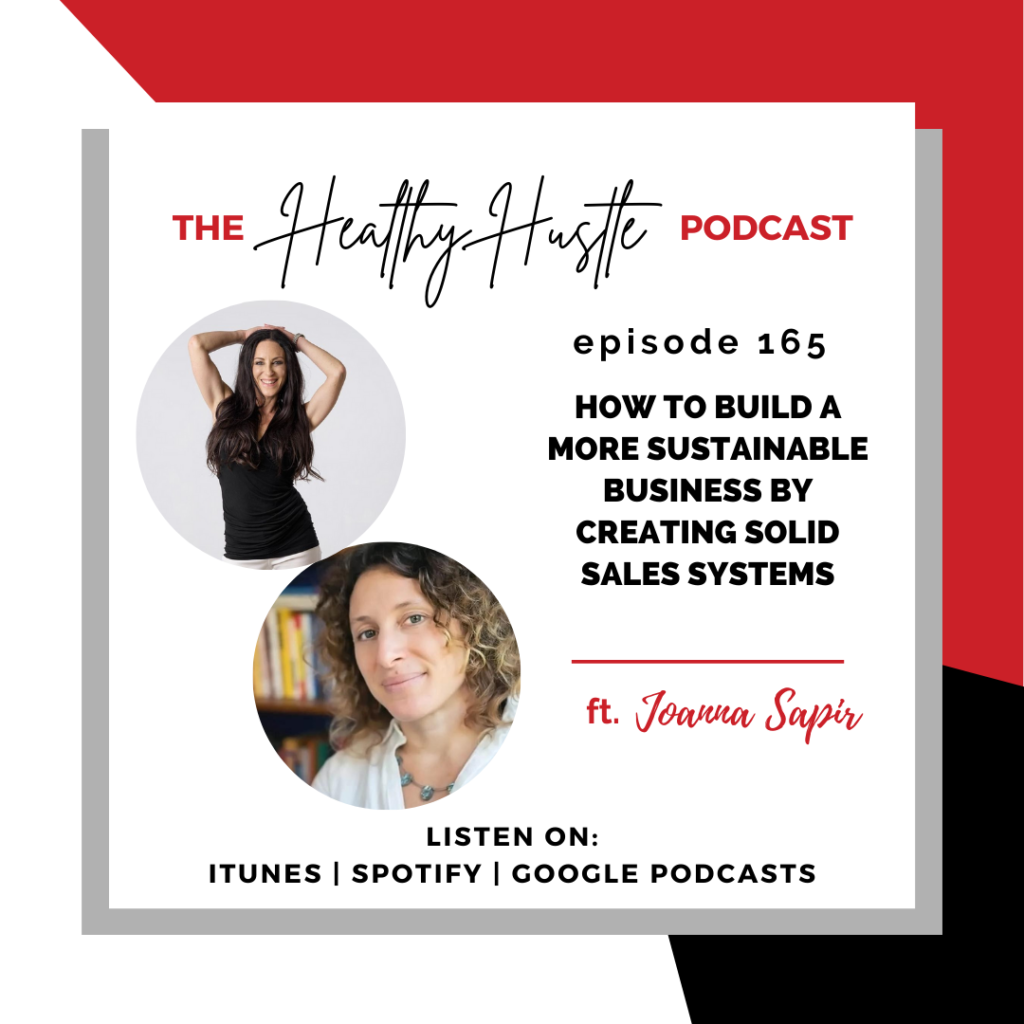
In today’s episode, I am talking to the incredible Joanna Sapir, a business strategist helping health and wellness practitioners, both brick and mortar and online, set up repeatable systems and processes in their businesses so they can serve their clients while building a more sustainable business.
I am so excited because Joanna and I are going to be talking about the core elements of a successful business, the importance of consultations (aka discovery calls), why marketing isn’t as essential as your sales process, how to prep and prime your audience for the sell, what to do when you’re potential client says no, and so much more.
If you’ve ever wondered how to build and move through the sales process in a way that feels aligned, isn’t pushy, but still lands clients, this episode is for you!
Connect with Joanna:
Website: https://joannasapir.com/
Free Training: www.joannasapir.com/healthyhustle
Podcast: https://joannasapir.com/business-revolution-podcast/
Rachel: Hey guys, I’m extremely excited to have Joanna with us today. She also works with health coaches, health practitioners, and we are going to be diving into what you guys so desperately need, the sales process. We’re gonna be talking about marketing, sales, and Joanna’s gonna describe exactly her process and what she teaches.
So without further ado, Joanna, can I just have you tell everyone a little about you?
Joanna: Thank you for having me, Rachel. So, probably like many people, I came into business myself with no background in business. I didn’t study business. I had been a public school teacher for 10 years, and almost accidentally ended up opening a strength and conditioning gym. I’m not going to go into the story there, but it wasn’t my dream or my vision or anything.
So I ended up opening the strength and conditioning gym, and learning right away, oh, I need to learn how to do business. You can’t just be great at what you do. I actually have all the teaching skills and all the athletic skills and everything to be providing the client services. But I did not know how to run a business. I didn’t know how to make a profitable business. I didn’t know how to make it sustainable for myself.
I hit a breaking point where I realized, oh, I have to learn how to do business. And so kind of set about doing that, making it a project and eventually deciding, okay, I want to build this business to be sellable so it can exist without me, like a legacy because I plan to move on and do other things. So I built it to be sellable.
Before I even sold it, I already knew what I wanted to do next, which was combining all my background in teaching and then now business and then in health and wellness. I wanted to help other wellness practitioners build their businesses to be profitable and sustainable. And particularly because I was the client, myself, of health coaches,of body workers, of various people providing me services, who were so good at what they did, and yet their businesses were struggling because they didn’t know their stuff in terms of the modality.
It was just because they didn’t have clear business systems and business processes and weren’t understanding what they were doing business wise and had never learned how to do that, had never spent the time and decided oh, yeah, I need to learn business. They spend a lot of time learning how to be better at health coaching. But not on the business stuff. So, 2017 is when I sold the gym and moved full time into what I do now, which is helping health and wellness practitioners, both brick and mortar and online, build more sustainable businesses.
Favorite Resources To Help Health Coaches Learn About Business
Rachel: What were some of the resources that you dove into to learn about business? I think that would be really helpful for anybody listening.
Joanna: It was so long ago, like 15 years ago. Initially, I started reading books and some of it was kind of dry. Probably the first book I got into was the E Myth. It’s a classic. It’s essentially about this issue of what I was just talking about, which is being a great practitioner doesn’t mean that you can have a successful business. You actually have to decide I’m going to be a great business owner.
One of the things I’ve learned over the years in teaching others and with myself is the message to everybody that you absolutely can learn how to do this. But if you hold on to some identity of, Oh, I’m so bad with money, or I don’t know what I’m doing with business, you can change that. You just go learn. This is not something that’s inherent. If you feel like other people seem to know what they’re doing and you don’t, it’s because they’ve learned. You can go learn, too.
Practitioners left and right, will go in for more advanced training, another certificate, which is amazing. I think it’s important to always uplevel but if that practitioner put the same amount of energy into learning, marketing, understanding the sales process, understanding the core elements, which I know you’re going to talk about, and what it takes to have a successful business. They would be able to have success.
Joanna: Absolutely. I agree with you. We should always keep learning to be better at what we’re doing. Where I think it’s a mistake is that sometimes people are doing more and more training to cope with a feeling of not being good enough. And when they are good enough they’ll know how to help people. But you are good enough, you’re helping your clients, you’re good enough.
Anybody could probably recognize that in him or herself or themselves if that’s what you’re doing. But what if you were to put that energy into learning how to run your business?You could do that all in one –finding somebody, a coach or a program or whatever that teaches you all kinds of things, or it could be one piece at a time. marketing, sales, profitability, financial management, etcetera. But what if you were to do that?
So yes, the great message to anyone listening is, Have you put the time and energy and investment of resources in learning how to run your business? If not, that’s a really important step. It all comes down to what are you really trying to achieve here? Do you want to have a business that’s really providing the things that you want it to provide for? If you want it go for it, go. Go learn how to do it.
The Core Elements Of A Successful Business
Rachel: I know you teach a lot about the core elements of a successful business. Before we even dive into the sales process, I think it’s extremely important for people to understand what are those elements that they need to be focusing on?
Joanna: Yeah, the sales process is one of the very first things I would focus on. Looking back, before I knew what a sales process was, I, along with everyone else, thought marketing is how we get clients. That’s what we think. I actually don’t believe that’s true.
The way we get clients is with the sales process. So marketing, to me, is how you attract attention. It’s how you bring people into your sphere, how you get noticed. It may be your nurturing of them as well. But sales is actually how you turn those people into clients. So that’s two different things. You can be doing all kinds of marketing. I don’t know about you, Rachel, but like, I’ve had practitioners come to me who have massive YouTube, or Instagram followings, and are making no money.
Rachel: I can think of one coach who has hundreds and hundreds of likes on every Reel, but has no clients. They’re marketing is thriving, but the sales process is not something that they’ve mastered.
Joanna: It is really common that we focus on marketing, and I actually think sales comes before marketing, because otherwise, what are you doing with 10,000 followers if you don’t know how to convert them to clients? So that’s actually one of the first things I teach is how to package your services so that you’re really getting people results. How can you really serve your clients most powerfully, so that they’re walking away with results? And are being your mouthpiece and are raving about you and telling other people about you? That’s bringing in referrals? That’s number one.
Then how do you enroll people in those services? That enrollment process is sales. So I actually think that that’s number one. I teach people the sales process even before they have anything going on with marketing.
Let’s say you get three people a month who reach out to you or somebody introduces three people to you. We think that that’s so little, three potential leads a month. But if you actually know how to convert those leads, if you can convert two, maybe three of those people out of the three each month, that’s two or three new clients a month. That’s really great for somebody who’s offering programs.
I definitely talked about not selling session by session and enrolling people in programs. And I think that you do too. So you offer the training or a single session as a low cost offer, as an entry to get them to your higher ticket package. Because if not, that person’s just going to be working without massive transformation.
Rachel: The clients are not going to feel the effect from it anyway.
Joanna: Exactly. So that’s what I teach is how to design those programs so that you’re really getting people results. It’s easy to put out a book Session Button. But if you’ve got something that’s $1,000, $2,000, $3,000, I know people who design programs that are $10,000 – how do I enroll somebody in that?
In the digital marketing world, a sales page is how sales are made in digital marketing, and those are for automated courses that are not one on one services, where you’re working directly with people or even small group services, where you’re really working directly with people.
Purchases from a sales page with a Buy Now button, I think conversion is somewhere around 2 to 10% conversion. On a sales page it would be really high. So that means that to get one client, you need lots of people to have visited that page first. And so you need traffic to that page. Whereas I teach a consultative sales approach, a consultative sales system, where you’re inviting people to, through your marketing, a consultation of some sort.
Rachel: I totally agree with you, I can’t tell you how many times I cringe when somebody says, Well, I don’t have the time for that. Well talk about that on the weekend, make it on the week night, you’re gonna have to find time, because that’s how you have a conversation with somebody. That’s how you fuel your business. I would have no business without making sales.
Are Consultation Calls A Waste Of Time?
Joanna: That brings up something Rachel that we can absolutely talk about, which is people only think it’s a waste of time to have a consultation, when they’re getting a bunch of people that don’t move forward. When they’re getting prospects that come into their consultation, if they’re doing 10 consultations, and only one person converts, it feels like a waste of time.
There’s all kinds of things we can do to stop that process. What I want to say is in the Sales System, I teach what I call The Predictable Sales System. Very basic name, but it is predictable. So my clients see around 80% conversion.
Now people start out, I say that even a low conversion rate is 50% –if you’re converting people to $2000, $3000, $4000, $5,000 programs or packages after that, it’s pretty darn worth it. Even if half of them don’t move forward.
That’s the most powerful thing you can learn in your business is how to enroll clients, because that’s what a business is. A business makes money to provide a service, that’s what you’re doing in consultation is getting the dollars and promising the services and then delivering the services after that. That’s what we’re talking about what business is made of.
How To Simplify Your Consultation Process
Rachel: In your Predictable Sales System? How long do you suggest your consultations are?
Joanna: They are an hour long, because they’re very in depth. But let me be clear, we put filters in place before the consultation so that you only have the actual hour-long consultation with somebody who has qualified. We have qualification measures in place, and the qualification process looks different.
For the way I teach it, if you’re a brick and mortar business, it actually starts with a brief phone call where you qualify. If you’re an online business, it’s an application. And you absolutely use that as a filter. So people may apply for a discovery call with me. I’ll look over that application and I may kindly refer them elsewhere if they’re not a right fit.
Those qualifications are based on you as an individual. Who are you? You have to do the insight, you have to look inside yourself and in your past data to know who are your yes clients and your no clients?
So part of your Yes clients is niche and specialty, but part of it is just personalities. It’s actually more than just demographics. It’s who are the people that are most committed? We actually look at who have been your worst clients? The clients you didn’t like working with or didn’t see results. We identify, why didn’t they see results? Why did you not like working with them? And if there are things about them, we identify those. Those are the things we’re filtering out.
Then there’s obvious filters around price, so asking whether something’s within somebody’s budget. So basically you’re not even doing a consultation with somebody unless they have passed through those filters. For example, price is a big one. Are they within their budget that’s already a given? That way, when they get to the consultation they have whatever commitment levels you’re looking for.
Another example is with a brick and mortar business, a filter might be around location and time commitment. Can you show up at this location, two sessions, twice a week or once a week, or whatever it is? Or there might be homework requirements. Are you committed? Can you put in the time and energy and effort to spend 10 to 15 minutes a day? If it’s a health coach, maybe it’s tracking your food, if it’s a body worker maybe it’s doing the stretches that I give you. Whatever. That all can be part of that filtering process.
So you can have a really strong filter, or you can have a weaker filter. If you’re pretty new in business, and you don’t have a lot of leads coming in, you’re going to want that filter to be wider open. Because you’re just going to want the experience of having consultations, talking to people, getting a sense of them, potentially enrolling them, but even just the experience of talking to people is going to benefit you.
So you have a more open filter, the newer you are, the less demand you have. If you have high demand, you’re going to want tighter filters.
Rachel: So clearly this person goes on this phone call to see if you guys are the right match.
How To Prime & Prep Your Audience For The Sell
Joanna: Totally, it is completely explicit. So another piece of that sales process of that sales system I teach is what I call the Prime and Prep Campaign. So after somebody has qualified through an application or a pre qualifying phone call, if it’s brick and mortar after they’ve qualified, they actually get a series of emails from you. That’s how we set it up.
Those emails are really priming them and prepping them for the consultation. So that involves a little bit of sharing about you and your story. So there’s a little bit of connection and bonding happening. But it’s also preparing them for making a decision. It’s almost like the beginning of the consultation, having them really get introspective.
To be really clear, Rachel, sales sounds like such a bad word. We think of used car salesmen, we think of pushy salespeople, we think of telemarketers. Sales does not have to be like that at all. Really, a sales process is not about you, as the practitioner convincing somebody to buy from you. It’s actually all about them.
Why The Consultation Call Isn’t About You
How I teach it, if you come onto my discovery call, I’m not telling you everything I do and my programs and why you should buy, I’m actually interviewing you and seeing what’s going on with you. Have you tried this? What have you tried? How did that work? I’m really diving into why are you here, what’s going on with your health, and really understanding where you’re at for a number of reasons.
One, I want to connect with you and see what this is really about. Two, and super important is, I only want to invite you to work with me if I know that I can help you, if my programs are designed in a way that are going to help you. I don’t want to enroll you if I’m not the right person to help you. So I’m really making sure of that by seeing what your situation is and if it’s out of my wheelhouse I want to refer you elsewhere. There may be things about your situation that I know is not my expertise. Or is it simply something I don’t want to do or someone I don’t want to work with for all kinds of reasons.
So it’s all about your prospect. It’s not about you, the practitioner, trying to convince somebody how great you are, it’s about them, and what are their needs? And can I fulfill those needs and help them?
How To Land The Sale Without Pitching Your Program
Rachel: And at what point in that discovery session process are you actually then talking about your program and enrolling them?
Joanna: It’s pretty neat. I call it No Pitch Selling. So I have 10 steps in the consultation and not a single one of those 10 steps is pitching the program. What you’re doing is identifying for the person in front of you what the problems are. So essentially, they’re coming to you with all this stuff that as a health coach, you’re gonna recognize. Oh, these are all symptoms of this problem. Usually our prospective clients don’t know what that problem is. They understand the symptoms and they often are mistaken on what they think the issue is but you can see because we have that expertise that they don’t.
So part of what I teach is, you identify the actual problems for them, the big overarching issue. So for example, somebody’s got all these symptoms, and you’re like this is hormone imbalance and so you’re showing them that, and that already is enlightening. So let’s say the problem is hormone imbalance, then you are actually teaching them what the solution is, but you’re doing it without pitching your program. You’re not teaching them the how, you’re teaching them the what.
So here are the steps, it might be three steps, it might be five steps, it might be three components to address hormone imbalance. What are those big picture pieces that they would need to do? Then it’s so natural after that they go, that’s amazing. Can you help me with that?
We actually have this question and answer portion of the consultation, where it’s like, yeah, I can help you with that. That’s exactly what I help people do. What questions do you have for me about what it would look like to work together? And they just start asking you questions, and you’re just answering questions about your program. You can be totally explicit and say you’re a perfect fit for this program. What questions do you have for me about potentially joining? Again, they’ve been primed and prepped already. They absolutely know this session was about determining whether they were going to work with you or not.
Part of the prime and prep as well is making sure people are prepared to know that you’re going to be asking them to make a decision. Now, most people are making a decision on the call itself, I don’t want to say that has to happen, it does not have to happen. But it is an expectation that your prospective client is going to get all the information they need in order to make a decision on the call, preferably. But if they need extra time, fine, but there’s going to be a decision made.
Steps To Take To Avoid A Potential Client Saying No
Rachel: That’s another one of those mistakes that a lot of folks make on a consultation or discovery call. They’re winging it, and just having a nice conversation. And when they just have a nice conversation, what you’ll inevitably get from the prospective client is okay, that’s great. Let me think about that. And then you never hear from them again. If somebody needs to think about it, schedule a follow up session right away.
Joanna: Yeah. So this is a very small percentage of people. This is not happening all the time. But I actually encourage practitioners to find out why you need to think about it? What is it? Because you’re right here, right now? Do a little digging. And it’s not to be pushy in any way. It’s just that we want to really open relationships. A lot of people have trouble just saying no. Whether it’s mostly as women or just our culture, it feels impolite to say, I’m not going to be moving forward.
I try to teach my clients to create an environment where, in the consultation, that is completely okay. So I never get off a call with somebody not knowing whether they are or aren’t. So I want to get to know if that’s what it is.
What I don’t want is for somebody to say I’ll think about it, when really they know that I’m not going to do this. So I would much rather get a no and get closure. The only time, to me, that you give the extra time is if somebody says I need to think about this, and exactly what it is that they have to deal with. Do they need to go see if they can move money around? Do they need to make sure that it fits in their schedule? Sometimes people are really in touch with themselves.
I love prospective clients that have this decision making process that involves X and they’ll tell me. They’ll be like, it involves me going and doing this and this and this. And it’s some spiritual kind of thing. But they have a process. That’s when I feel very, very confident and I’m like great. So now I know that whether it’s a yes or no, they have some specific process and it’s going to be a really grounded decision. Great. But I don’t get off the call until I know that.
What is it that you’re gonna go do? In that case, I simply say to them, great, how long does that take? What’s the timeframe? Before you tell me yes or no, I always make it clear like yes or no, either answer is okay. I’m looking at creating that safe space.
Rachel: I do a 30 minute discovery call. But when you’re selling much higher ticket packages, you need an hour to be able to go back and forth, have room for those questions, and have space for the person on your call to feel safe enough to really express what they need.
Joanna: Exactly. It is about that safety. Part of that safety is making it really clear that it’s okay for you to tell me that you don’t want to do this. So I actually asked them, when are you going to let me know? And they set the date and time for the follow up.
How To Handle Potential Clients Saying No
Rachel: A lot of coaches have that lack of confidence, even though they’ve put their program together, they feel that they included everything. I think that to be able to have a really consistent sales process, you need to have that confidence about yourself.
Joanna: Yeah. There’s confidence and there’s inner work that we all have to do in holding capacity for. It’s interesting. If we have rejection wounds, then we know that hearing a no is going to trigger that. And that’s our own work that we have to do is actually feeling okay hearing no. But if you have that and know that it’s hard for you to say no to people, because that feels like you’re hurting them. Or if you have trouble hearing No, that’s some work to do with yourself.
Because it’s important for people who feel that to know that you can get to a place where no is simply no, it doesn’t have any story around it. There’s no story about you or anything, it’s like some things aren’t a fit, or somebody’s just not in the right place. Most of all, when it comes to health coaching, when people aren’t ready to move forward, that’s about them. Most of the time that’s not about you, that’s about them, and their lack of confidence in themselves, that they will actually be able to do this. So anyway, you can get to a place where there’s no story around that for you. And it’s just simply data.
How To Package Your Program
Rachel: Talk to me a little about packaging and pricing, because the packaging of your program, and how you’ve put it together, allows you also to show up in that confidence space? So what are your suggestions when it comes to packaging your program?
Joanna: I come from a different place than a lot of people do. In that the process I use to guide practitioners in creating their programs is basically completely separate from marketing and what we think the market wants from the process.
I actually start with, who are your ideal clients? We have to start there. Because otherwise you make 17 different packages. Who are your ideal clients? Who are the people you most want to work with? Because you love working with them, and they see the best results from your services. That’s the intersection we’re looking for. Who are those people?
And then we take those people, and I actually have my folks actually think of specific people that they worked with, who were those ideal clients? If you could go back to when you first met them, and first started working with them, what is the journey? Or the process that they needed? Starting from day one? What is that journey? My perspective on this is how can you provide the most powerful results for them? Don’t even think about how in the world you would market this or sell this, we do that after we start with what do people really need?
And a lot of times that’s very different from what they want. So it’s like they forget about what they want, and what they really need. So that’s where we start. And it’s really interesting because I don’t prescribe for people that it should be three months long, or it should be six months long or any of that. I just help them through deciding what it would look like. I’ve worked with people who have done a six week long kind of first steps and I’ve had year long is the first step.
After that, we don’t even design what the next steps are until they actually start taking people through those first steps and then see, Ah, here’s what the next step is. If there’s a next step like some kind of continuity program or maintenance program. So those look really different. We do it based on what you believe your clients really need, then we figure out how to market, then we determine the positioning and the marketing and the selling for that.
If for example somebody has a really intensive year long program, that’s a very large investment. They can enroll people straight into that but it really depends on what they already have going on in their business. They don’t necessarily need some smaller first step kind of piece. It really depends on what their existing assets are in the business, what the existing size of their audience is. In fact, people with very small audiences are the ones often who can enroll people directly into the big program. But over time, we might develop some smaller first steps to begin.
Why The Pricing Calculator Is Your New Business Bestie
As far as pricing goes, this is different. If it’s one on one versus groups, none of my clients are selling DIY courses. They’re all doing direct work with their clients. So I have a pricing calculator that we use, and it’s pretty much by the numbers. So it’s different than if you’re selling a DIY course, which is what we see a lot out there in terms of what the gurus are teaching. And in that case, you are making up for the price because if you sell 10, versus if you sell 2000, it’s all profit, because you’re actually not putting in the time. Whereas for us, you’re actually having client facing time.
What you were asking me at the beginning, about really having profitable and sustainable businesses, we start with the pricing calculator. It starts with knowing, what’s my ideal schedule? How much time do I want to be working in my business? And then we actually split up those hours, how many hours are client facing hours? How many hours are working on marketing? How many hours are working on sales? If you have a team, how many hours are working on leading your team, etc?
And then it goes to what are my profit goals? What are my income goals? What are my salary goals? How much do I want to be paid? I think it’s a common mistake that people pay themselves whatever’s left at the end of the month. Instead, we use the pricing calculator, we build your salary in. So your salary is an expense, it’s not what’s left. It’s not the profit, profit is different than salary. So profit is everything leftover after all your expenses, and that includes your salary. So we build in profit goals. And then we’re working backwards for the pricing, we’re looking at all the expenses of the business, profit goals, your salary, needs, etc.
We work backwards to determine a minimum price for your program. From there, we finesse it for marketing and sales. That’s how we do pricing. It’s very much by the numbers.
Rachel: I love that part about the schedule, and really identifying what you want. Because I think if somebody doesn’t want to work too much, and you want these high goals and financial, it’s really hard to get there. And then you’re going to be constantly feeling overwhelmed, and you’re gonna feel that you’re not doing enough or not doing good enough. I love that.
The Importance Of Being Realistic With Your Business
Joanna: To me, you get in the right relationship with reality. What’s the reality? Tim Ferriss talks about the four hour workweek, but, you can say you want to work four hours a week, and make $20,000 a month, you can say that, but let’s be realistic. You’ve got to look at the reality.
Sometimes what you want is actually not realistic. But most of the time, it totally is. It’s just a matter of actually looking at it. And it may mean that you need to charge a lot more and there’s the reality check for you. How much would you need to charge to make this much and work this many hours? Can you do that?
I’ve never had a practitioner work with me where I thought no way you can’t sell that I’ve never had that. It’s them. It’s their learning the sales process and that confidence that you’re talking about to go yeah, this is definitely worth it for the client. The outcomes are definitely worth what this is priced at. And so that’s us as practitioners learning how to do that process and the thing is, once you get one person, you get more.
Rachel: For a lot of my people, they got new pricing and a new program. And then they learn the sales process and it’s a milestone to bring the first person through, it’s when you bring that first person through, it only takes one that changes everything for you. It’s one of those things which realign you with the fact that you’re doing your purpose.
Joanna: Exactly. So I just had a client, for example, who, before coming to me with selling session by session or packs of sessions, which is not the same thing as a program, she came to me, we built her program, etc. It’s $9,800, she just enrolled her first person for $9,800. Once that happens, you just realize, Oh my God, this totally can happen. Now she gets to work with them.
It’s also just such a different ballgame when you’re working with somebody who has enrolled in that process. They’ve invested that much in themselves. But you’ve designed this container to work with them that is really going to provide them amazing result. It is so powerful. It feels so different to work with someone in that context than it does when it’s something low priced or something session by session or just a pack of sessions. It’s a completely different experience.
How To Get More Visible Online So You Can Make Sales
Rachel: Are there general ways that you suggest for visibility? Do you have people that do workshops, masterclasses, opt-in freebies? Do you teach a certain method for that?
Joanna: And to me, this is where it gets really individualized when I’m working with clients, because to me, it really depends on their own strengths. A lot of my people that come to me are like me, a former teacher. So it’s very natural and comfortable for me to be in the front of a classroom, either physically in person, or even online, teaching groups of people. So workshops, really structured in a very particular way, are one of my favorite ways to do it. I do a lot of free stuff. So I teach my clients who also are really comfortable teaching to do that as well. But it really depends on who they are and also what assets they bring.
So for example, I have people who come to me who have been in business for 20 years and they actually have what I would call an email list, but they never have done any kind of email marketing whatsoever. So they have 1000 people that have at some point over 20 years, scheduled a session with them or worked with them in some way. And that, to me, is low hanging fruit, you don’t need to go find new people, when you’ve got 1000 people on a list.
For those folks, I’m teaching them how to nurture their list and then provide invitations for those people to take next steps and move forward. So it just depends. I don’t have one thing, but since you asked, I absolutely encourage everybody to develop a lead magnet over time. And I love webinars and workshops as a form of getting people in, but here I am guesting on your podcast. That’s also definitely a lead generation method.
There’s a bunch of things and how I teach it, which I’m sure you do, too, is it’s not actually about the tactic. It’s really about understanding the strategy of how do I get in front of new people who have never heard of me? How do I get them in? How do I capture them as leads and get them into my world? How do I nurture them? How do I get them into my sales pipeline? Which is as simple as inviting them to that first step in the sales process, which is your free consultation, your free discovery call, whatever it is.
Rachel: Wow, you just went through everything about the sales process, and also getting new leads and nurturing. I can’t tell you how amazing this episode has been. We touched on packaging/pricing. We touched on structured sales calls and what that entails. I think that every coach listening to this is either going to hire you or they’re going to definitely follow you and say I need to absorb more.
Joanna: Well, I do have a free training. I have a masterclass that is a recording that you can watch where I really lay out the whole structure of all this put together and how it looks all put together super, super useful for any health coach, and you can get that at Joannasapir.com/healthyhustle.
Rachel: Perfect. Thank you so much for being here today. I really love the easiness of how you teach. I love that we really touched on those core elements of a successful business. And I think that anybody listening to this is really going to get some great value. Can you tell everyone your website as well as file?
Joanna: My website is Joannasapir.com. And if you go there, you can see quite a few different free resources are available to you. If you want to schedule a discovery call with me, you’ll see that button right there because that’s that invitation. I have a podcast called the Business Revolution for Practitioners with Joanna Sapir.
Rachel: Amazing. Be sure to follow this woman. She’s got great energy, really easy to talk to. So I definitely know that your discovery session with her will be a blast.

